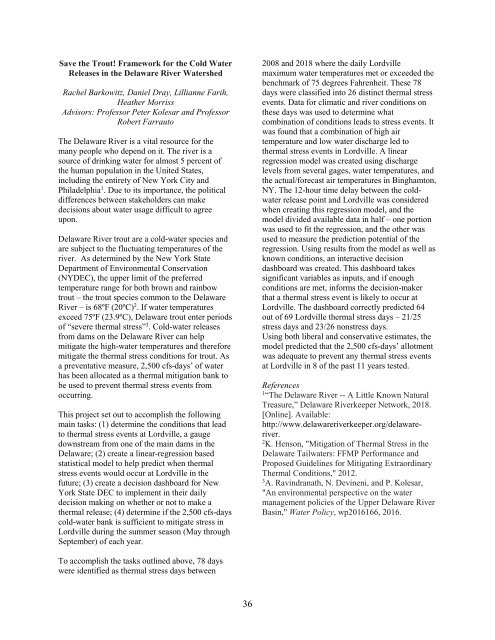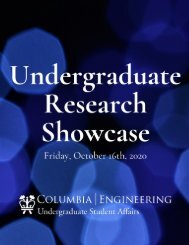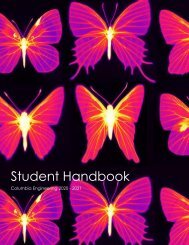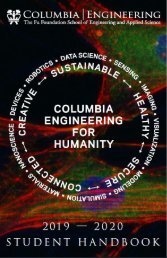Senior Design Expo 2019
The Senior Design Expo, held annually in May at Columbia University, is an opportunity for Columbia Engineering students to showcase what they have learned in their foundational math and science courses together with their engineering courses in innovative, creative, and purposeful designs and prototypes. Each year the Expo showcases more than 60 projects across all nine departments. Projects have included cutting-edge robotics, the New York City subway system, language technology, proposals for bridges to span the Hudson river, and much more.
The Senior Design Expo, held annually in May at Columbia University, is an opportunity for Columbia Engineering students to showcase what they have learned in their foundational math and science courses together with their engineering courses in innovative, creative, and purposeful designs and prototypes. Each year the Expo showcases more than 60 projects across all nine departments. Projects have included cutting-edge robotics, the New York City subway system, language technology, proposals for bridges to span the Hudson river, and much more.
Create successful ePaper yourself
Turn your PDF publications into a flip-book with our unique Google optimized e-Paper software.
Save the Trout! Framework for the Cold Water<br />
Releases in the Delaware River Watershed<br />
Rachel Barkowitz, Daniel Dray, Lillianne Farih,<br />
Heather Morriss<br />
Advisors: Professor Peter Kolesar and Professor<br />
Robert Farrauto<br />
The Delaware River is a vital resource for the<br />
many people who depend on it. The river is a<br />
source of drinking water for almost 5 percent of<br />
the human population in the United States,<br />
including the entirety of New York City and<br />
Philadelphia 1 . Due to its importance, the political<br />
differences between stakeholders can make<br />
decisions about water usage difficult to agree<br />
upon.<br />
Delaware River trout are a cold-water species and<br />
are subject to the fluctuating temperatures of the<br />
river. As determined by the New York State<br />
Department of Environmental Conservation<br />
(NYDEC), the upper limit of the preferred<br />
temperature range for both brown and rainbow<br />
trout – the trout species common to the Delaware<br />
River – is 68ºF (20ºC) 2 . If water temperatures<br />
exceed 75ºF (23.9ºC), Delaware trout enter periods<br />
of “severe thermal stress” 3 . Cold-water releases<br />
from dams on the Delaware River can help<br />
mitigate the high-water temperatures and therefore<br />
mitigate the thermal stress conditions for trout. As<br />
a preventative measure, 2,500 cfs-days’ of water<br />
has been allocated as a thermal mitigation bank to<br />
be used to prevent thermal stress events from<br />
occurring.<br />
This project set out to accomplish the following<br />
main tasks: (1) determine the conditions that lead<br />
to thermal stress events at Lordville, a gauge<br />
downstream from one of the main dams in the<br />
Delaware; (2) create a linear-regression based<br />
statistical model to help predict when thermal<br />
stress events would occur at Lordville in the<br />
future; (3) create a decision dashboard for New<br />
York State DEC to implement in their daily<br />
decision making on whether or not to make a<br />
thermal release; (4) determine if the 2,500 cfs-days<br />
cold-water bank is sufficient to mitigate stress in<br />
Lordville during the summer season (May through<br />
September) of each year.<br />
2008 and 2018 where the daily Lordville<br />
maximum water temperatures met or exceeded the<br />
benchmark of 75 degrees Fahrenheit. These 78<br />
days were classified into 26 distinct thermal stress<br />
events. Data for climatic and river conditions on<br />
these days was used to determine what<br />
combination of conditions leads to stress events. It<br />
was found that a combination of high air<br />
temperature and low water discharge led to<br />
thermal stress events in Lordville. A linear<br />
regression model was created using discharge<br />
levels from several gages, water temperatures, and<br />
the actual/forecast air temperatures in Binghamton,<br />
NY. The 12-hour time delay between the coldwater<br />
release point and Lordville was considered<br />
when creating this regression model, and the<br />
model divided available data in half – one portion<br />
was used to fit the regression, and the other was<br />
used to measure the prediction potential of the<br />
regression. Using results from the model as well as<br />
known conditions, an interactive decision<br />
dashboard was created. This dashboard takes<br />
significant variables as inputs, and if enough<br />
conditions are met, informs the decision-maker<br />
that a thermal stress event is likely to occur at<br />
Lordville. The dashboard correctly predicted 64<br />
out of 69 Lordville thermal stress days – 21/25<br />
stress days and 23/26 nonstress days.<br />
Using both liberal and conservative estimates, the<br />
model predicted that the 2,500 cfs-days’ allotment<br />
was adequate to prevent any thermal stress events<br />
at Lordville in 8 of the past 11 years tested.<br />
References<br />
1<br />
“The Delaware River -- A Little Known Natural<br />
Treasure,” Delaware Riverkeeper Network, 2018.<br />
[Online]. Available:<br />
http://www.delawareriverkeeper.org/delawareriver.<br />
2<br />
K. Henson, "Mitigation of Thermal Stress in the<br />
Delaware Tailwaters: FFMP Performance and<br />
Proposed Guidelines for Mitigating Extraordinary<br />
Thermal Conditions," 2012.<br />
3<br />
A. Ravindranath, N. Devineni, and P. Kolesar,<br />
"An environmental perspective on the water<br />
management policies of the Upper Delaware River<br />
Basin," Water Policy, wp2016166, 2016.<br />
To accomplish the tasks outlined above, 78 days<br />
were identified as thermal stress days between<br />
36








